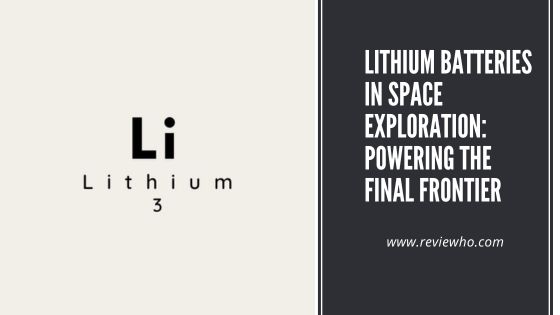Introduction Space exploration has always been driven by the pursuit of knowledge and the desire to unlock the mysteries of the universe. One critical aspect of space missions is power, as it is essential for communication, propulsion, life support systems, and scientific experiments. While traditional power sources like solar panels and fuel cells have played a significant role, lithium batteries are increasingly becoming a key player in powering space exploration.
This article explores the use of lithium batteries in space missions, their advantages, challenges, and the future of battery technology in the final frontier.
Understanding Lithium Batteries
Lithium batteries are rechargeable energy storage devices that utilize lithium ions to facilitate the flow of electricity. They consist of a positive electrode (cathode), a negative electrode (anode), and an electrolyte. Lithium batteries offer several advantages over other power sources, such as high energy density, lightweight design, and the ability to be recharged multiple times. These characteristics make them ideal for space missions, where every gram of weight and every bit of energy efficiency counts. However, there are also challenges associated with lithium batteries, including temperature extremes and safety concerns that must be addressed for their successful use in space.
A. Basic composition and functionality
- The structure of a lithium battery: cathode, anode, and electrolyte
- Lithium-ion movement during charge and discharge cycles
- Role of separators and current collectors
B. Advantages of lithium batteries over other power sources
- High energy density: more power in a compact size
- Lightweight design: reducing payload weight in space missions
- Rechargeable capability: multiple cycles of use and recharge
- Low self-discharge rate: longer shelf life and mission durations
- Wide operating temperature range: adaptability to space conditions
C. Challenges and limitations of lithium batteries in space
- Temperature extremes: impact on battery performance
- Safety concerns: risk of thermal runaway and fire hazards
- Radiation exposure: degradation of battery cells over time
- Limited energy capacity: addressing the need for more power in long-duration missions
By understanding the basic composition and functionality of lithium batteries, it becomes evident why they are a preferred power source for space exploration. Their high energy density and lightweight design allow for efficient use of space and weight constraints in spacecraft. Additionally, the rechargeable capability and low self-discharge rate ensure long-lasting power availability. However, challenges such as temperature extremes, safety concerns, radiation exposure, and limited energy capacity require ongoing research and development efforts to overcome these limitations and maximize the potential of lithium batteries in space missions.
Powering Spacecraft with Lithium Batteries
Lithium batteries find applications in various aspects of space exploration. Satellites and communication systems heavily rely on lithium batteries to ensure continuous operation and power availability in orbit. Robotic missions, such as planetary rovers, depend on lithium batteries to power their scientific instruments and propulsion systems. Moreover, human spaceflight missions utilize lithium batteries for life support systems, including environmental control and life support systems (ECLSS), spacesuit functions, and power backup. Lithium batteries enable longer mission durations, reduce the need for frequent maintenance, and provide efficient power management for space missions. To purchase lithium batteries for your space exploration needs, you can conveniently buy direct from store.
Performance Benefits of Lithium Batteries in Space
The high energy density of lithium batteries allows for prolonged mission durations, as they can store a significant amount of power in a small and lightweight package. This advantage is particularly crucial for deep space missions where solar power may not be feasible. Additionally, the compact design of lithium batteries enables efficient use of limited spacecraft real estate. Their rechargeability allows for multiple cycles of power use and recharging, reducing the need for frequent battery replacements. The efficient power management systems in lithium batteries also ensure optimal utilization of power resources and help prolong mission lifetimes.
Overcoming Challenges
Space presents unique challenges for the use of lithium batteries. Extreme temperatures can affect battery performance and longevity. In space, temperatures can range from extreme cold in shadowed regions to intense heat when exposed to direct sunlight. Thermal regulation techniques, such as insulation and heating elements, are employed to maintain battery performance in these harsh conditions. Furthermore, radiation exposure poses a significant challenge to battery reliability. Space radiation can cause damage to battery cells and degrade their performance over time. Radiation-hardened battery designs and shielding are employed to minimize the effects of radiation and ensure the reliability of power systems.
Safety Considerations and Risk Mitigation
Safety is of utmost importance in space missions, and lithium batteries are no exception. Preventing thermal runaway and battery failures is crucial to avoid catastrophic consequences. Stringent safety protocols, including robust containment systems and emergency shutdown procedures, are in place to mitigate the risk of battery malfunctions. Continuous monitoring and advanced battery management systems help ensure safe operation throughout the mission duration.
Future Developments and Innovations
Battery technology continues to evolve, and future developments hold promise for space exploration. Solid-state batteries, which use solid electrolytes instead of liquid ones, offer potential benefits such as higher energy density, improved safety, and wider temperature range operation. Research is also focused on next-generation lithium-ion and lithium-air batteries, aiming to further enhance energy density and power output. Additionally, the integration of lithium batteries with renewable energy sources like solar panels and fuel cells can provide sustainable power solutions for long-duration space missions.
Read: Sustainable Sourcing of Lithium for Battery Production
Conclusion
Lithium batteries have become indispensable in space exploration, powering satellites, robotic missions, and human spaceflight. Their high energy density, lightweight design, and efficient power management make them ideal for the demands of space missions. While challenges such as temperature extremes, radiation exposure, and safety concerns exist, ongoing research and development efforts are continuously improving battery technology for space. The future holds exciting possibilities, including solid-state batteries and advanced lithium-based technologies, which will further enhance mission capabilities and contribute to scientific discoveries beyond Earth’s bounds. With lithium batteries as a reliable power source, the final frontier of space exploration becomes even more attainable.




